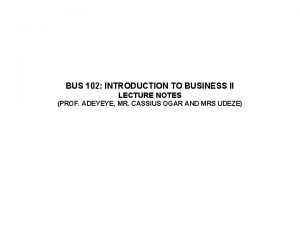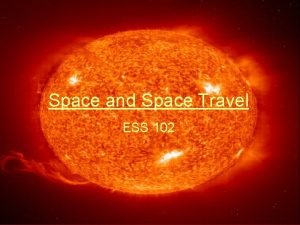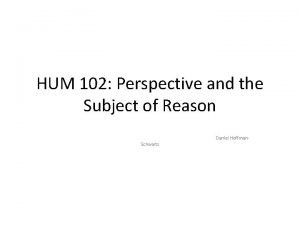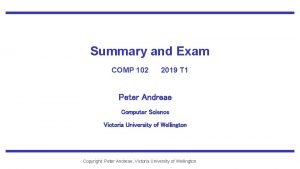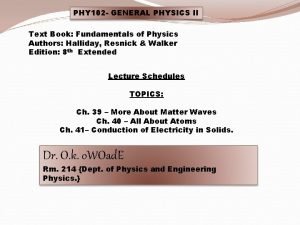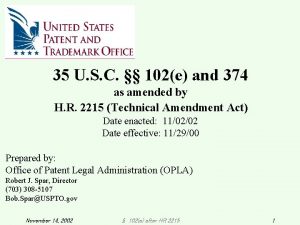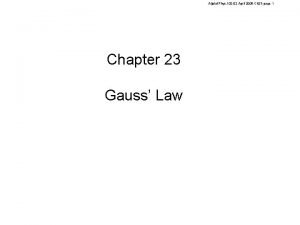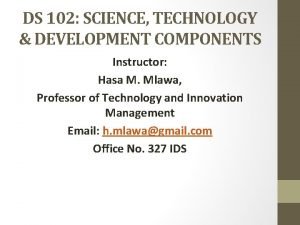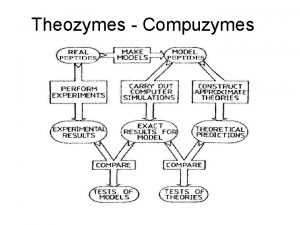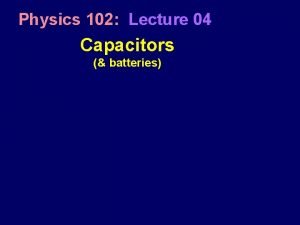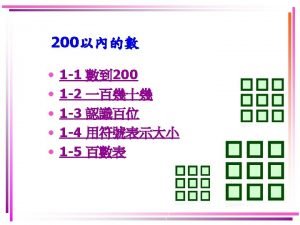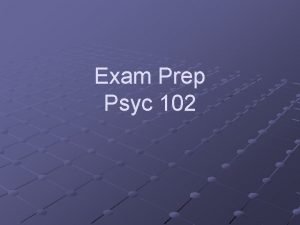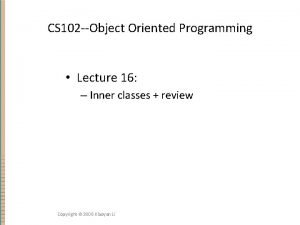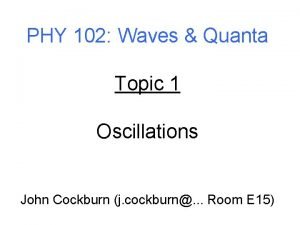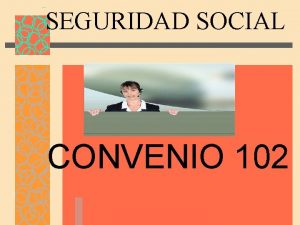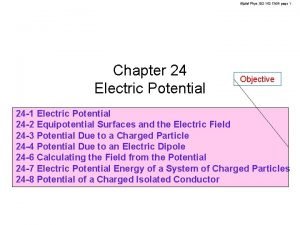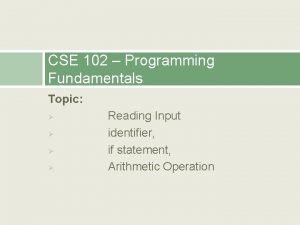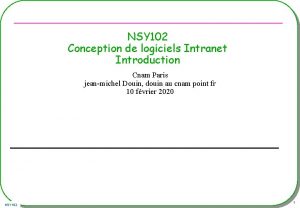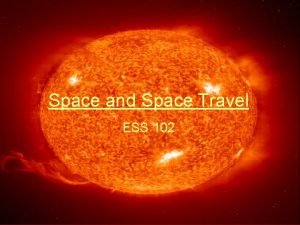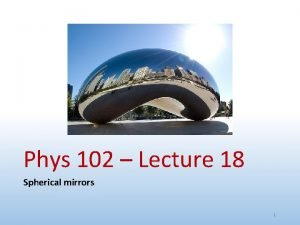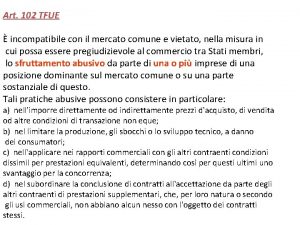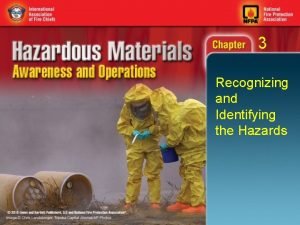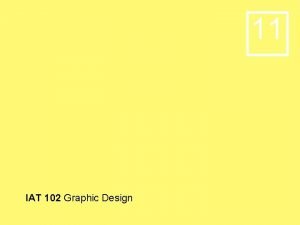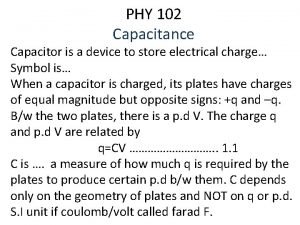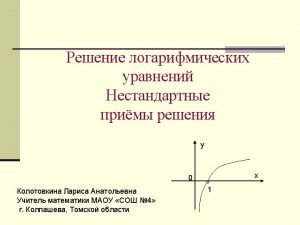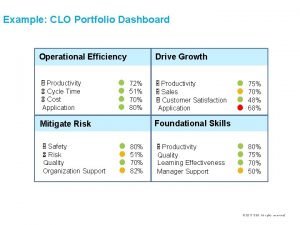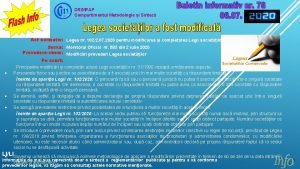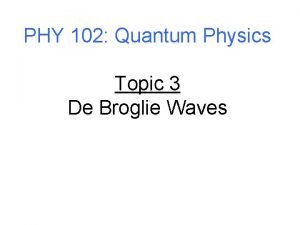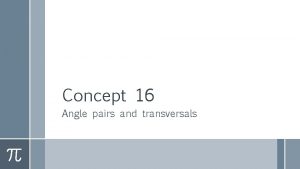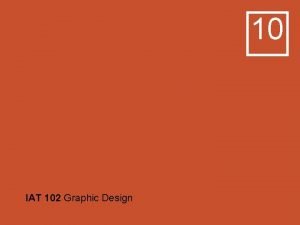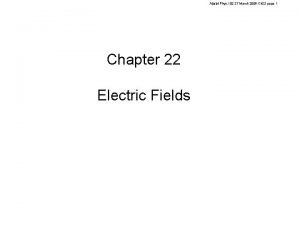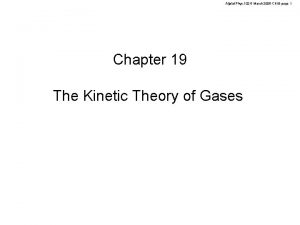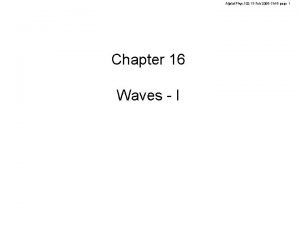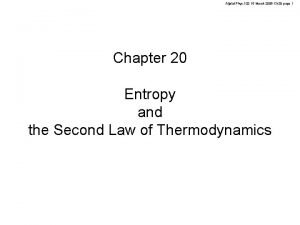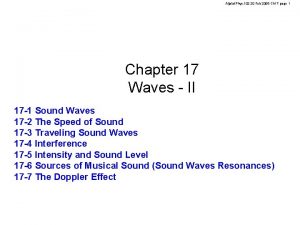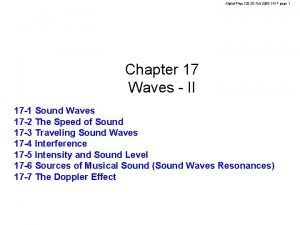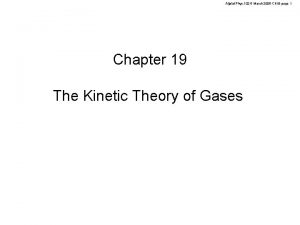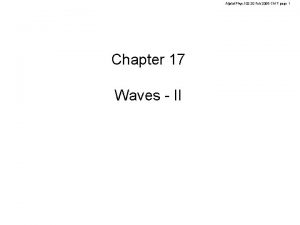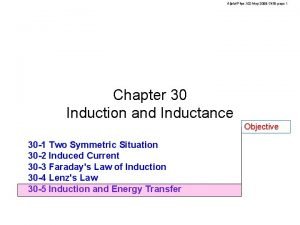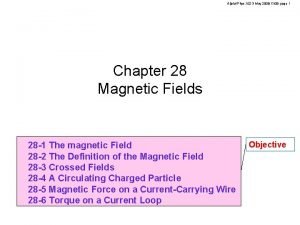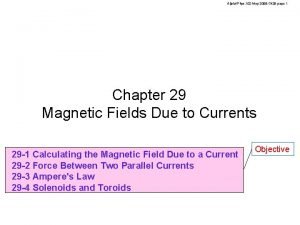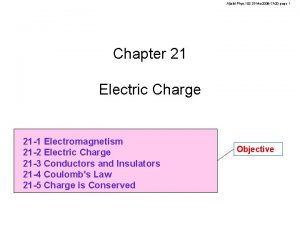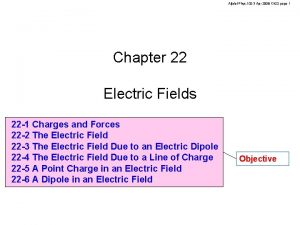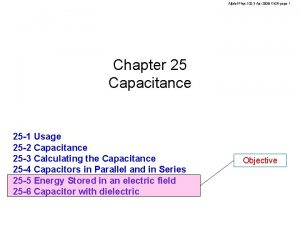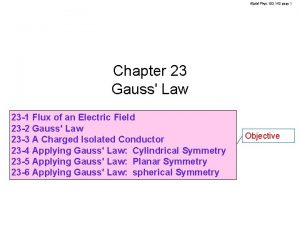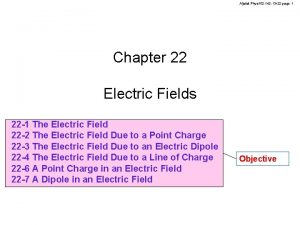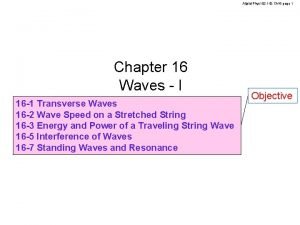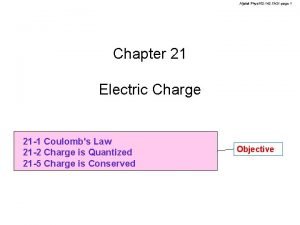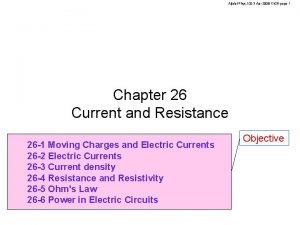AljalalPhys 102 02 April 2006 Ch 23 page






















































- Slides: 54

Aljalal-Phys. 102 -02 April 2006 -Ch 23 -page 1 Chapter 23 Gauss’ Law

Aljalal-Phys. 102 -02 April 2006 -Ch 23 -page 2 23 -1 A New Look at Coulomb’s Law Gauss' Law Same as Very useful in calculating the eclectic field from symmetrical shapes Spheres, cylinders, … Coulomb' Law

Aljalal-Phys. 102 -02 April 2006 -Ch 23 -page 3 23 -3 Flux of an Electric Field Gauss' Law Gaussian surface If you know the electric field over any imaginary closed surface, you can calculate the net electric charge inside this closed surface

Aljalal-Phys. 102 -02 April 2006 -Ch 23 -page 4 23 -3 Flux of an Electric Field Gaussian surface imaginary sphere You can guess that the net charge inside the Gaussian surface is positive charge You can guess that the net charge inside the Gaussian surface is negative charge

Aljalal-Phys. 102 -02 April 2006 -Ch 23 -page 5 23 -3 Flux of an Electric Field Gauss' Law e 0 (Electric flux through any closed surface) = charge inside the surface e 0 F = qenc permittivity constant

Aljalal-Phys. 102 -02 April 2006 -Ch 23 -page 6 23 -3 Flux of an Electric Field Electric flux through a Gaussian surface Integration over a closed surface Area vector

Aljalal-Phys. 102 -02 April 2006 -Ch 23 -page 7 23 -3 Flux of an Electric Field Gauss' Law e 0 (Electric flux through any closed surface) = charge inside the surface e 0 F = qenc

Aljalal-Phys. 102 -02 April 2006 -Ch 23 -page 8 23 -3 Flux of an Electric Field Vector area Magnitude : Direction : Gaussian surface is an imaginary closed surface Area of the small surface Normal to the surface And pointing to the outer side of the closed surface

Aljalal-Phys. 102 -02 April 2006 -Ch 23 -page 9 23 -3 Flux of an Electric Field Dot product: review q Scalar quantity 900

Aljalal-Phys. 102 -02 April 2006 -Ch 23 -page 10 23 -3 Flux of an Electric Field 900 Flux through area 450

Aljalal-Phys. 102 -02 April 2006 -Ch 23 -page 11 23 -3 Flux of an Electric Field The magnitude of the electric field is proportional to the electric field lines per unit area perpendicular to the lines is proportional to the electric field lines passing though area The electric flux F though a Gaussian surface is proportional to the net number of electric field lines passing through that surface

Aljalal-Phys. 102 -02 April 2006 -Ch 23 -page 12 23 -3 Flux of an Electric Field Sample Problem 23 -1 Find the flux of the electric field though the closed surface of the cylinder total flux = flux through surface a + flux though surface b + flux though surface c 900 a c b

Aljalal-Phys. 102 -02 April 2006 -Ch 23 -page 13 y 23 -3 Flux of an Electric Field Checkpoint 1 A Gaussian cube of face area A immersed in a uniform electric field E pointing along the positive direction of z axis A z Flux though the front face =EA Flux though the rear face = -EA Flux though the top face =0 Flux though the whole cube =0 x

Aljalal-Phys. 102 -02 April 2006 -Ch 23 -page 14 23 -3 Flux of an Electric Field Sample Problem 23 -2 y What is the electric flux though the right face? cube z x =1 m x =3 m x Right face

Aljalal-Phys. 102 -02 April 2006 -Ch 23 -page 15 23 -3 Flux of an Electric Field Sample Problem 23 -2 y left face What is the electric flux though the left face? cube z x =1 m x =3 m x

Aljalal-Phys. 102 -02 April 2006 -Ch 23 -page 16 23 -3 Flux of an Electric Field Sample Problem 23 -2 top face y What is the electric flux though the top face? cube z x =1 m x =3 m x

Aljalal-Phys. 102 -02 April 2006 -Ch 23 -page 17 23 -4 Gauss’ Law Gauss' Law e 0 (Electric flux through any closed surface) = charge inside the surface e 0 F = qenc

Aljalal-Phys. 102 -02 April 2006 -Ch 23 -page 18 23 -4 Gauss’ Law Electric field is outward for all points on this closed surface. Flux and charge inside are both positive. No Charge inside the surface. Electric Field lines entering the surface also leaving it Electric field is inward for all points on the surface. Flux and charge inside are both negative Net charge inside this closed surface is zero. Number of the electric field lines entering the surface = number of lines leaving it.

Aljalal-Phys. 102 -02 April 2006 -Ch 23 -page 19 23 -4 Gauss’ Law Checkpoint 2 Numbers indicate the flux on each face and arrows indicate the direction of the electric lines What kind of charge enclosed by these Gaussian cubes? 5 10 3 7 3 3 4 2 7 No net charge 6 8 2 5 4 6 Positive net charge 5 7 5 Negative net charge

Aljalal-Phys. 102 -02 April 2006 -Ch 23 -page 20 23 -4 Gauss’ Law Sample Problem 23 -3 neutral q 5 q 1 q 3 S q 1 = q 4=+3. 1 n. C q 2 = q 5= -5. 9 n. C q 3 = -3. 1 n. C q 4 q 2 What is the net electric flux though the Gaussian surface S? e 0 F = qenc

Aljalal-Phys. 102 -02 April 2006 -Ch 23 -page 21 23 -5 Gauss’ Law and Coulomb’s Law Gauss' Law Same as Coulomb' Law Gauss’ Law q Gaussian spherical surface of radius r Coulomb’s Law

Aljalal-Phys. 102 -02 April 2006 -Ch 23 -page 22 23 -5 Gauss’ Law and Coulomb’s Law Checkpoint 3 Small spherical surface What is the relation between the electric flux though the three Gaussian surfaces? q Solution All have the same flux through them Cubical surface Large spherical surface

Aljalal-Phys. 102 -02 April 2006 -Ch 23 -page 23 23 -6 A Charged Isolated Conductor inside E=0 -e Free electrons always present in any conductor If inside E≠ 0, free electrons move Electrostatic equilibrium Not electrostatic equilibrium. In electrostatic equilibrium, the electric field inside a conductor is zero

Aljalal-Phys. 102 -02 April 2006 -Ch 23 -page 24 23 -6 A Charged Isolated Conductor In electrostatic equilibrium Conductor Gaussian surface inside the conductor Since the electric field inside the conductor = 0 inside E=0 Flux through any Gaussian surface inside the conductor = 0 Net charge inside the conductor = 0 In electrostatic equilibrium, all excess charge on a conductor is entirely on the conductor’s outer surface

Aljalal-Phys. 102 -02 April 2006 -Ch 23 -page 25 23 -6 A Charged Isolated Conductor electrostatic equilibrium Conductor inside cavity totally within the conductor E=0 Flux though the closed surface = 0 No net charge inside the surface No net charge on a cavity wall which is totally within a conductor

Aljalal-Phys. 102 -02 April 2006 -Ch 23 -page 26 23 -6 A Charged Isolated Conductor E =0 No conductor E =0 Same charge distribution Same electric field Electric field is produced by the charge distribution

Aljalal-Phys. 102 -02 April 2006 -Ch 23 -page 27 23 -6 A Charged Isolated Conductor Lower charge density Conductor sphere Uniform charge distribution Electric field is very easy to calculate Higher charge density Conductor charge distribution is not uniform In general, electric field is very difficult to calculate

Aljalal-Phys. 102 -02 April 2006 -Ch 23 -page 28 23 -6 A Charged Isolated Conductor Lower charge density Higher charge density Choose very small area on the conductor’s surface such that the surface is almost flat and the charge distribution is almost uniform Conductor charge distribution is not uniform In general, electric field is very difficult to calculate But we can find the electric field just neat the surface by using Gauss’ law

Aljalal-Phys. 102 -02 April 2006 -Ch 23 -page 29 23 -6 A Charged Isolated Conductor Electrostatic equilibrium 900 Conductor Electric field is perpendicular to the surface of conductors

Aljalal-Phys. 102 -02 April 2006 -Ch 23 -page 30 23 -6 A Charged Isolated Conductor If electric field is not perpendicular to the surface of conductor, Free electrons always present on surface of conductor -e Conductor component of E along the surface free electrons move Not electrostatic equilibrium. In electrostatic equilibrium, electric field is perpendicular to the surface of conductors

Aljalal-Phys. 102 -02 April 2006 -Ch 23 -page 31 23 -6 A Charged Isolated Conductor Cross section Conductor Gaussian surface Area of the cylinder cap =A

Aljalal-Phys. 102 -02 April 2006 -Ch 23 -page 32 23 -6 A Charged Isolated Conductor Flux through the rear cap = 0 Since inside conductor Flux through the cylinder surface = 0 Since Conductor Flux through the front cap = E A Since inside conductor Total electric flux through the cylinder = E A e 0 F = qenc e 0 E A = qenc surface charge density

Aljalal-Phys. 102 -02 April 2006 -Ch 23 -page 33 23 -6 A Charged Isolated Conductor Electric field just near the surface of a conductor surface charge density Magnitude: Direction: Perpendicular to the conductor’s surface Conductor Positively charged Conductor Negatively charged

Aljalal-Phys. 102 -02 April 2006 -Ch 23 -page 34 23 -6 A Charged Isolated Conductor Sample Problem 23 -4 q= -5 m. C Neutral spherical metal shell What is the induced charges on the inner surface? R q R/2 metal = conductor Inside the conductor, E = 0 Electric flux through the Gaussian surface = 0 Gaussian Surface q e 0 F = qenc = 0 Net charge inside the Gaussian surface = 0 q + Charge on the inner surface of the shell = 0 Charge on the inner surface of the shell = - q = + 5 m. C -q

Aljalal-Phys. 102 -02 April 2006 -Ch 23 -page 35 23 -6 A Charged Isolated Conductor Sample Problem 23 -4 What is the induced charges on the outer surface? Neutral spherical metal shell The metal shell is neutral Net charge of the shell = 0 +q q -q Charge on the outer surface + Charge on the inner surface = 0 Charge on the outer surface = - Charge on the inner surface Charge on the outer surface = - (-q) = q Charge on the outer surface = - 5 m. C

Aljalal-Phys. 102 -02 April 2006 -Ch 23 -page 36 23 -6 A Charged Isolated Conductor Sample Problem 23 -4 Are the charges induced on the inner surface uniformly distributed? q The point charge inside the shell repels electrons strongly from this area. More positive The point charge inside the shell repels electrons weakly from this area. less positive On the inner surface, charge are not uniformly distributed

Aljalal-Phys. 102 -02 April 2006 -Ch 23 -page 37 23 -6 A Charged Isolated Conductor Sample Problem 23 -4 Are the charges induced on the outer surface uniformly distributed? Since in the conductor E = 0, q the inside charges can not affect (applying force) on the outer charges. Charges on the outer spherical surface distribute themselves to minimize the forces among themselves On the outer surface, charge is uniformly distributed.

Aljalal-Phys. 102 -02 April 2006 -Ch 23 -page 38 23 -6 A Charged Isolated Conductor Checkpoint 4 What is the charge on the shell’s inner and outer surfaces? Metal shell net charge - 100 e -50 e + 50 e -150 e Solution

Aljalal-Phys. 102 -02 April 2006 -Ch 23 -page 39 23 -7 Applying Gauss’ Law: Cylindrical Symmetry What is the electric felid at a distance r from the axis? Infinity 900 Infinitely long cylindrical rod with a uniform linear charge density l From symmetry, the electric field points along the radial direction Infinity

Aljalal-Phys. 102 -02 April 2006 -Ch 23 -page 40 23 -7 Applying Gauss’ Law: Cylindrical Symmetry Cylindrical Gaussian cylinder of radius r and coaxial with the rod r 900 Flux through the upper and lower caps = 0 Since h Since flux through the cylinder surface = E( area of the cylinder surface = E ( 2 p r h) Total electric flux through the Gaussian surface = E ( 2 p r h) e 0 F = qenc e 0 E (2 p r h) = qenc Linear charge density

Aljalal-Phys. 102 -02 April 2006 -Ch 23 -page 41 23 -7 Applying Gauss’ Law: Cylindrical Symmetry Magnitude: 900 outward in radial direction 900 inward in radial direction

Aljalal-Phys. 102 -02 April 2006 -Ch 23 -page 42 23 -7 Applying Gauss’ Law: Cylindrical Symmetry Sample Problem 23 -5 Cloud What is the radius of the visible lightening column ? To see light E > 3 x 106 N/C Lightening l = - 1 x 10 -3 C/m Earth -e N 2 Nitrogen Before collision N 2 Light if E > 3 x 106 N/C -e After collision

Aljalal-Phys. 102 -02 April 2006 -Ch 23 -page 43 23 -8 Applying Gauss’ Law: Planar Symmetry What is the electric felid from thin infinite nonconducting sheet? From symmetry, the electric field is perpendicular to the sheet Cross section A Thin infinite nonconducting sheet Cylindrical Gaussian surface with cap area of A

Aljalal-Phys. 102 -02 April 2006 -Ch 23 -page 44 23 -8 Applying Gauss’ Law: Planar Symmetry Cross section Flux through the cylinder surface = 0 Since Flux through the right cap = Flux through the left cap =EA Total electric flux through the cylinder = E A + E A = 2 E A e 0 F = qenc e 0 (2 E A) = qenc surface charge density

Aljalal-Phys. 102 -02 April 2006 -Ch 23 -page 45 23 -8 Applying Gauss’ Law: Planar Symmetry Nonconducting sheets Cross section s 1 Surface charge density s 2 Surface charge density Cross section s 1 s 2 Superposition

Aljalal-Phys. 102 -02 April 2006 -Ch 23 -page 46 23 -8 Applying Gauss’ Law: Planar Symmetry Conducting sheets Cross section put charge No charge inside the conductor. All charge on the surface s s For conductors, we assign charge density for each side 2 sconductor = snonconductor.

Aljalal-Phys. 102 -02 April 2006 -Ch 23 -page 47 23 -8 Applying Gauss’ Law: Planar Symmetry Conducting sheets Cross section s 0 Cross section -s 0 Cross section Superposition of the electric fields

Aljalal-Phys. 102 -02 April 2006 -Ch 23 -page 48 23 -8 Applying Gauss’ Law: Planar Symmetry Conducting sheets Cross section Flux = 0 since E =0 s = - 2 s 0 Flux = E A s =2 s 0 Flux =- E A

Aljalal-Phys. 102 -02 April 2006 -Ch 23 -page 49 23 -8 Applying Gauss’ Law: Planar Symmetry Sample Problem 23 -6 Two nonconducting large sheets s(+) = 6. 8 m. C/m 2 s(-) = 4. 3 m. C/m 2 Find the electric field to the right, between and to the left of the two plates Cross section s(+) To the left To the right s(-)

Aljalal-Phys. 102 -02 April 2006 -Ch 23 -page 50 23 -9 Applying Gauss’ Law: spherical Symmetry A thin, uniformly charged spherical shell with total charge q and of radius R r>R e 0 F = qenc r R Similar to the electric field from a point charge placed at the center of the sell A shell of uniform charge attracts or repels a charged particle that is outside the shell as if all the shell’s charge were concentrated at its center.

Aljalal-Phys. 102 -02 April 2006 -Ch 23 -page 51 23 -9 Applying Gauss’ Law: spherical Symmetry A thin, uniformly charged spherical shell with total charge q and of radius R r<R e 0 F = qenc = 0 R r If a charged particle is located inside a shell of uniform charge, there is no net electrostatic force on the particle from the shell.

Aljalal-Phys. 102 -02 April 2006 -Ch 23 -page 52 23 -9 Applying Gauss’ Law: spherical Symmetry A sphere of radius R and with total charge q uniformly charged throughout its volume r>R e 0 F = qenc r R

Aljalal-Phys. 102 -02 April 2006 -Ch 23 -page 53 23 -9 Applying Gauss’ Law: spherical Symmetry A sphere of radius R and with total charge q uniformly charged throughout its volume r<R e 0 F = qenc R r

Aljalal-Phys. 102 -02 April 2006 -Ch 23 -page 54 23 -9 Applying Gauss’ Law: spherical Symmetry Large nonconducting sheets with identical positive uniform charge surface density Checkpoint 5 Rank electric field at points, greatest first Solution 1 3 and 4 tie then 2 then 1 2 Electric field due the sheets is zero. You need only to consider the field from the sphere d s 0 4 3 d d Sphere with uniform positive charge density s 0
 April 2006 calendar
April 2006 calendar School calendar 2005-2006
School calendar 2005-2006 American association for artificial intelligence 17 mar
American association for artificial intelligence 17 mar Title page
Title page Guess the next number 101 102 103 104 105 106 107 108 109
Guess the next number 101 102 103 104 105 106 107 108 109 Eng 102 bilkent
Eng 102 bilkent Bus 102 pdf
Bus 102 pdf Ess 102
Ess 102 Bisc 102 sfu
Bisc 102 sfu Hum 102
Hum 102 Comp 102
Comp 102 Info 102
Info 102 George carlin aging philosophy
George carlin aging philosophy Physics 102
Physics 102 35 usc 102
35 usc 102 102 cube
102 cube Ds-102
Ds-102 Asp 102
Asp 102 Physics 102 electricity and magnetism
Physics 102 electricity and magnetism Bcd addition of 184 and 576
Bcd addition of 184 and 576 Hum 102
Hum 102 Physics 102
Physics 102 Csc 102
Csc 102 101 102 103
101 102 103 Psychology 102 practice test
Psychology 102 practice test Cs 102 midterm
Cs 102 midterm 102 bc meaning
102 bc meaning Iat 102
Iat 102 102
102 Convenio 102 norma minima de seguridad social
Convenio 102 norma minima de seguridad social Aljalal phys 102
Aljalal phys 102 Cse102
Cse102 102 dr
102 dr Jmx 102
Jmx 102 Ess 102
Ess 102 102
102 Learnability flexibility robustness
Learnability flexibility robustness Art.102 tfue
Art.102 tfue Mc 338
Mc 338 Nur 102
Nur 102 Physics 102
Physics 102 Math102 kfupm
Math102 kfupm Area 102
Area 102 Weingart
Weingart Nur 102
Nur 102 102 capacitor
102 capacitor Lgx=5
Lgx=5 Clo-102
Clo-102 Legea nr. 102/2020
Legea nr. 102/2020 I 102 104
I 102 104 Phys 102 uiuc
Phys 102 uiuc Convenio 102 oit
Convenio 102 oit Physics 102
Physics 102 In the figure m 3 = 102 find the measure of each angle
In the figure m 3 = 102 find the measure of each angle Josef muller brockmann beethoven
Josef muller brockmann beethoven






